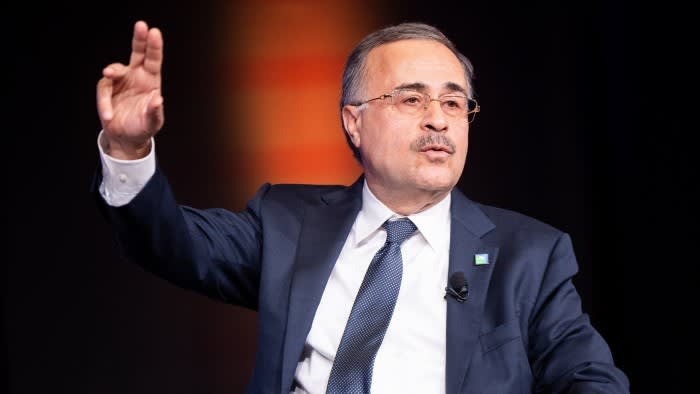
Unlock the Editor’s Digest for free
Roula Khalaf, Editor of the FT, selects her favourite stories in this weekly newsletter.
Saudi Aramco’s chief executive has praised China’s contribution to helping the west hit its net zero targets as the world’s largest oil producer strengthens commercial ties with Beijing.
Speaking at World Energy Congress on Monday, Amin Nasser defended China against the accusations that it was “dumping” cheap solar panels and electric vehicles on Europe.
“China really helped by reducing the cost of solar energy,” he said in Rotterdam. “A lot of what happened in solar panels is because of what China did in terms of reducing [prices]. We can see the same now in electric vehicles. Their cost is one-third to one-half the cost of other electric vehicles. So we need globalisation and collaboration if we are going to achieve our energy targets by 2050.”
As the west tries to reduce its oil consumption, Saudi Aramco has turned to China and other markets for growth.
On Monday, Aramco outlined its latest in a number of tie-ups with China’s large petrochemical producers, each designed to ensure the state-controlled Saudi company has committed buyers in the future for its crude.
It said it planned to buy a 10 per cent stake in the $15bn refiner Hengli Petrochemical, one of China’s leading producer of chemicals for plastics. “We are excited by the prospect of expanding our presence in the important Chinese market,” said Aramco executive Mohammed Al Qahtani.
China is the biggest market for Saudi crude and increasingly important for Aramco’s ambitions to convert 4mn barrels a day of its oil production — approximately 40 per cent of its current output — into petrochemicals by 2035.
Last year, Aramco acquired a 10 per cent stake in Shenzhen-listed Rongsheng Petrochemical for $3.6bn and entered a venture with two other Chinese companies to build a 300,000 b/d refinery and petrochemicals complex.
Nasser said that western policymakers were misjudging the future energy consumption of developing countries as they drew up climate targets.
“A lot of the policymakers do not understand what is required and how [energy transition] is going to happen,” he said. “Eighty per cent of the consumption of hydrocarbons [oil and gas] by 2050 is going to be in the Global South. Today it is 40 per cent in the Global North and 60 per cent in the Global South. So that is huge growth in the Global South,” he said.
Aramco has set targets to cut its operational emissions to net zero by 2050 by capturing and storing carbon but it has no plans to reduce the amount of oil and gas it produces.
Nasser said Aramco would also invest more in cleaner forms of energy but had struggled to find a market for products such as hydrogen.
“We are trying to help in the transition by bringing hydrogen to the market. But you know, you need a deal for 15 to 20 years. When we put prices out we found it difficult to sign these agreements,” he said, adding that the current price compared to a $200-$400 barrel of oil.
The debate around climate targets was “very emotional” he said. “The focus of everyone should be about reducing emissions. But you cannot invest for the industry now, it is total chaos I have to say. Total chaos, the whole debate and the whole discussion.”
Climate Capital

Where climate change meets business, markets and politics. Explore the FT’s coverage here.
Are you curious about the FT’s environmental sustainability commitments? Find out more about our science-based targets here
